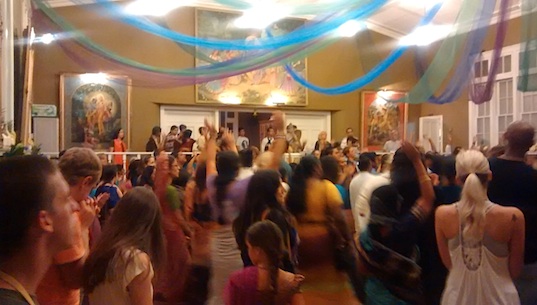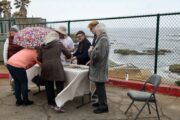It’s a Friday evening in Laguna Beach, an affluent seaside city in Orange County. In a converted two-story former Baptist church a short walk from the beach, a couple of hundred lay devotees of the International Society for Krishna Consciousness (ISKON), also known as the Hare Krishna movement, have gathered at the Laguna Beach ISKON temple. This special Friday evening event is in honor of Swami Radhanath, a Jewish American-born sadhu visiting from Maharashtra, India where he has resided for several decades.
As the devotees await Swami Radhanath’s entrance, I sit cross-legged on the floor among the devotees. We’re listening to the melodious chanting of Kirtan–the call-and-response style of singing the mantra “Hare Krishna, Hare Krishna, Krishna Krishna, Hare Hare”–accompanied by the mridanga, khartal and harmonium. On the walls around us are ornate paintings depicting Lord Krishna and his devotees. And facing us is a raised wooden altar displaying five garlanded figurines depicting the pancha tattva–the five features of Lord Krishna as they were incarnated on earth.
At first glance this Hare Krishna congregation looks a lot like the stereotype of Southern California’s fringe culture: mostly young and white. But along with white women dressed in saris and dreadlocked young white men with jappa beads around their necks is a surprisingly diverse array of Hare Krishna devotees, including a significant number of men, women and children of South Asian descent. From leading the congregation in the devotional chanting to organizing the ritual practices of the temple, South Asians–many of them young second-generation Americans–figure centrally in the temple’s spiritual practice.
This snapshot of the Hare Krishna movement in Southern California reflects larger socio-cultural shifts in the movement’s American presence over the past four decades. In particular, the vibrant scene in Laguna Beach is a testament to how the group has adapted and innovated in the midst of claims regarding its deviant cult status by reconfiguring itself as a broad-based religious phenomenon.
The Hare Krishna movement, or ISKON, is based on the teachings of the 15th-century philosopher Caitanya Mahaprabhu and was founded in New York City by Bhaktivedanta Swami Prabhupada, who arrived in the United States from India in 1965 to propagate global missionary Vaishnavism in the West. Swami Prabhupada’s visit coincided with the landmark Immigration and Nationality Act that reversed decades of exclusionary immigration policies and led to a wave of Asian immigrants, attracting in particular South Asian professionals seeking opportunities in the U.S.
At first, however, the participation of South Asian Hindu immigrants in the incipient movement was minimal. Indeed, Swami Prabhupada remained ambivalent about involving Indians in ISKON out of a concern that it would be conflated with Hinduism and its implied sectarianism. Swami Prabhupada’s stated aspirations were more inclusive and cosmopolitan, though this led him at times to speak negatively about the new immigrant families’ desires to achieve what he perceived as the materialistic American dream. Instead, his missionization was primarily organized to appeal to the young, mostly white hippie and bohemian culture of America at the time.
Only later, when the movement was more established, did Swami Prabadupada encourage Indians to become involved. This outreach became imperative in the mid 1970s when ISKON faced a growing threat from anti-cult activists, and stronger alliances with Indian Hindus offered ISKON cultural authenticity. Today, the growing participation of Indian American Hindus in the temple’s activities offers not only legitimacy in the eyes of the public but also financial solvency, as first- and second-generation Indians, an influential and affluent segment of American society, donate to the temples.
Thus at a time when many declining mainstream Christian churches are receiving a fresh lease on life as a result of new immigrant membership, betwixt and between Indian American Hindu immigrants are serving as key cultural liaisons to facilitate ISKON’s assimilation into the mainstream religious landscape. What began as a missionary movement evolved into a countercultural phenomenon and has now come to embrace both its South Asian roots as well as its cachet among successive generations of American spiritual seekers. As the Hare Krishna Tree continues to grow, the seams of these successive grafts will no doubt become increasingly more difficult to discern.
Nalika Gajaweera was a senior research analyst with the USC Center for Religion and Civic Culture through 2023.








